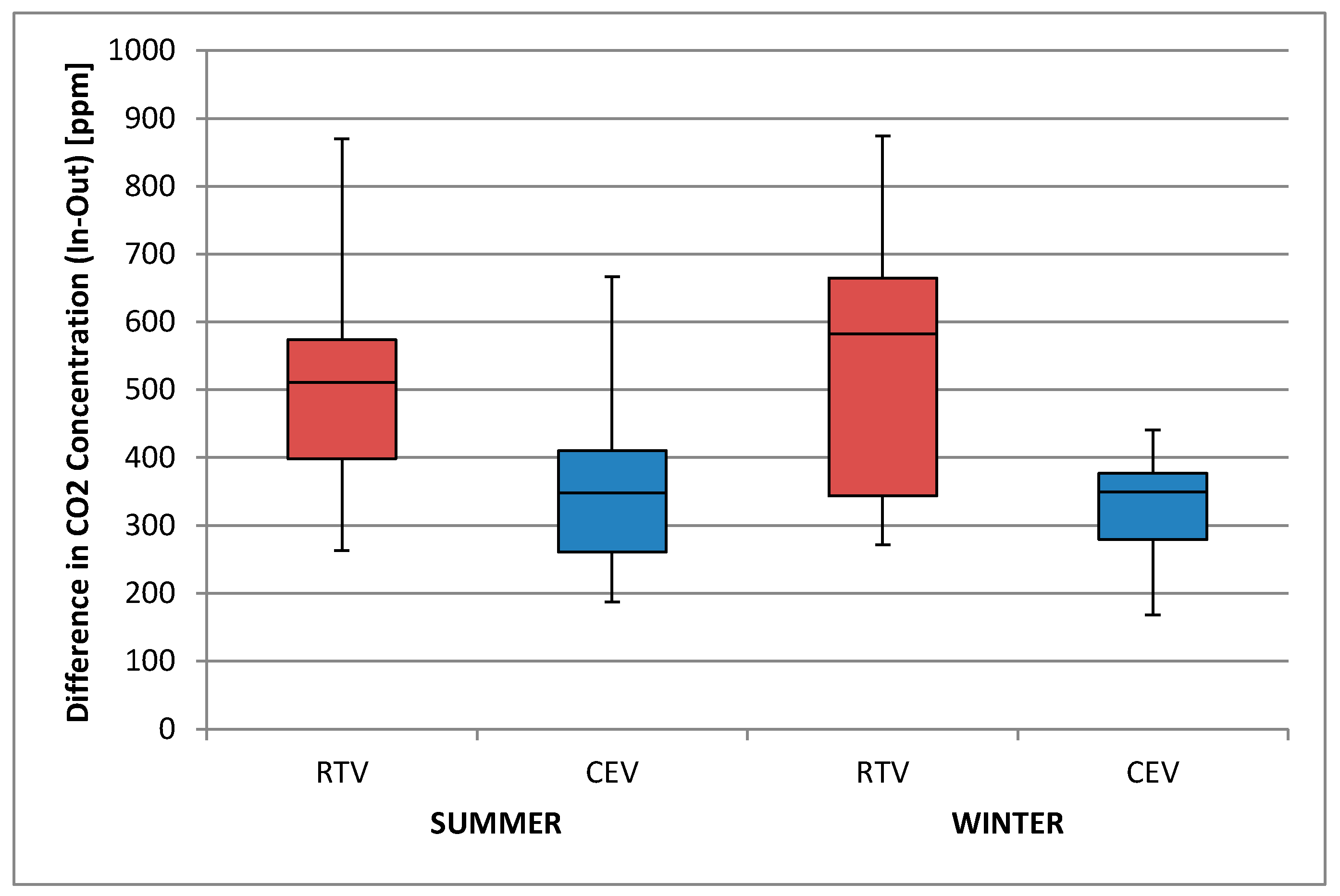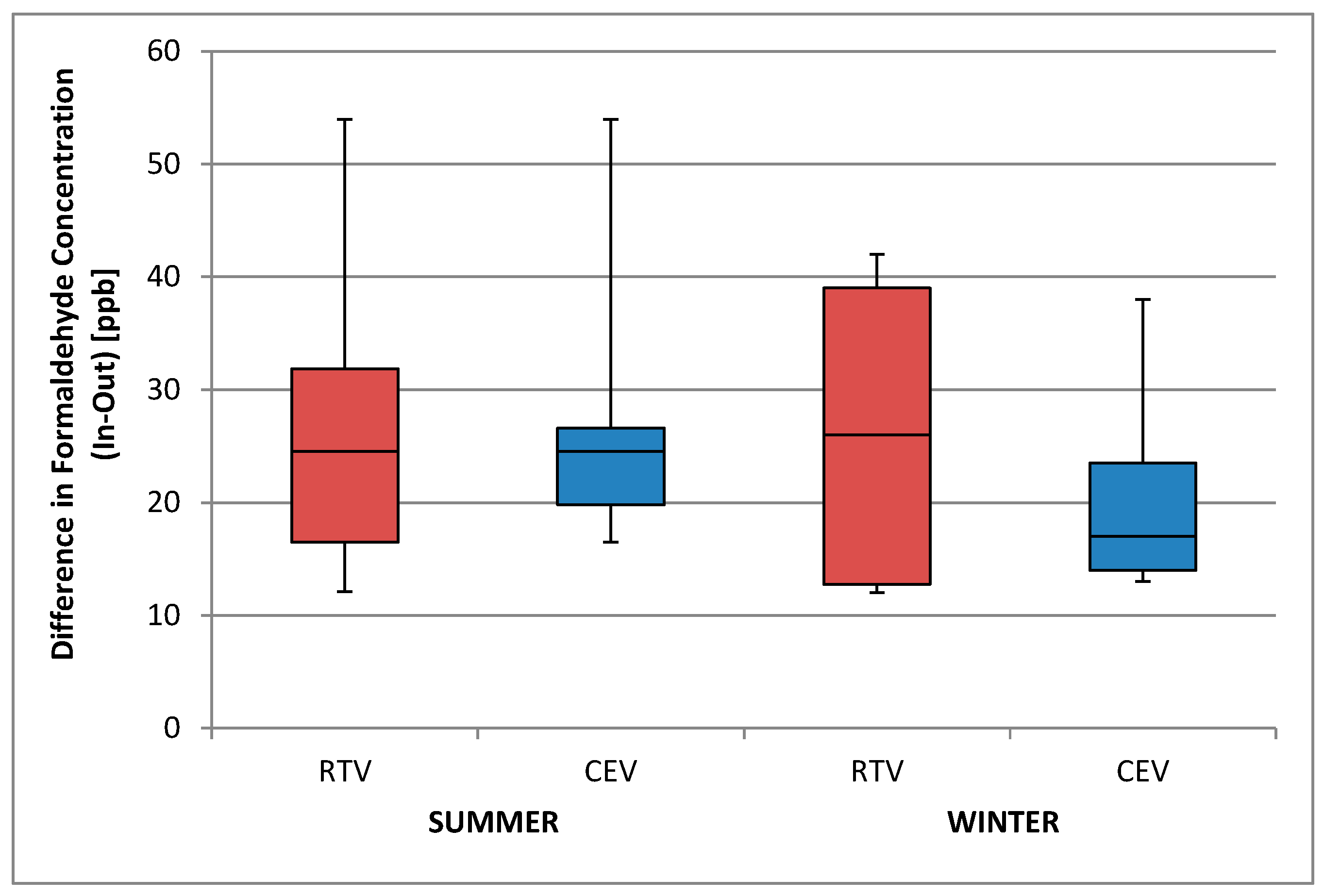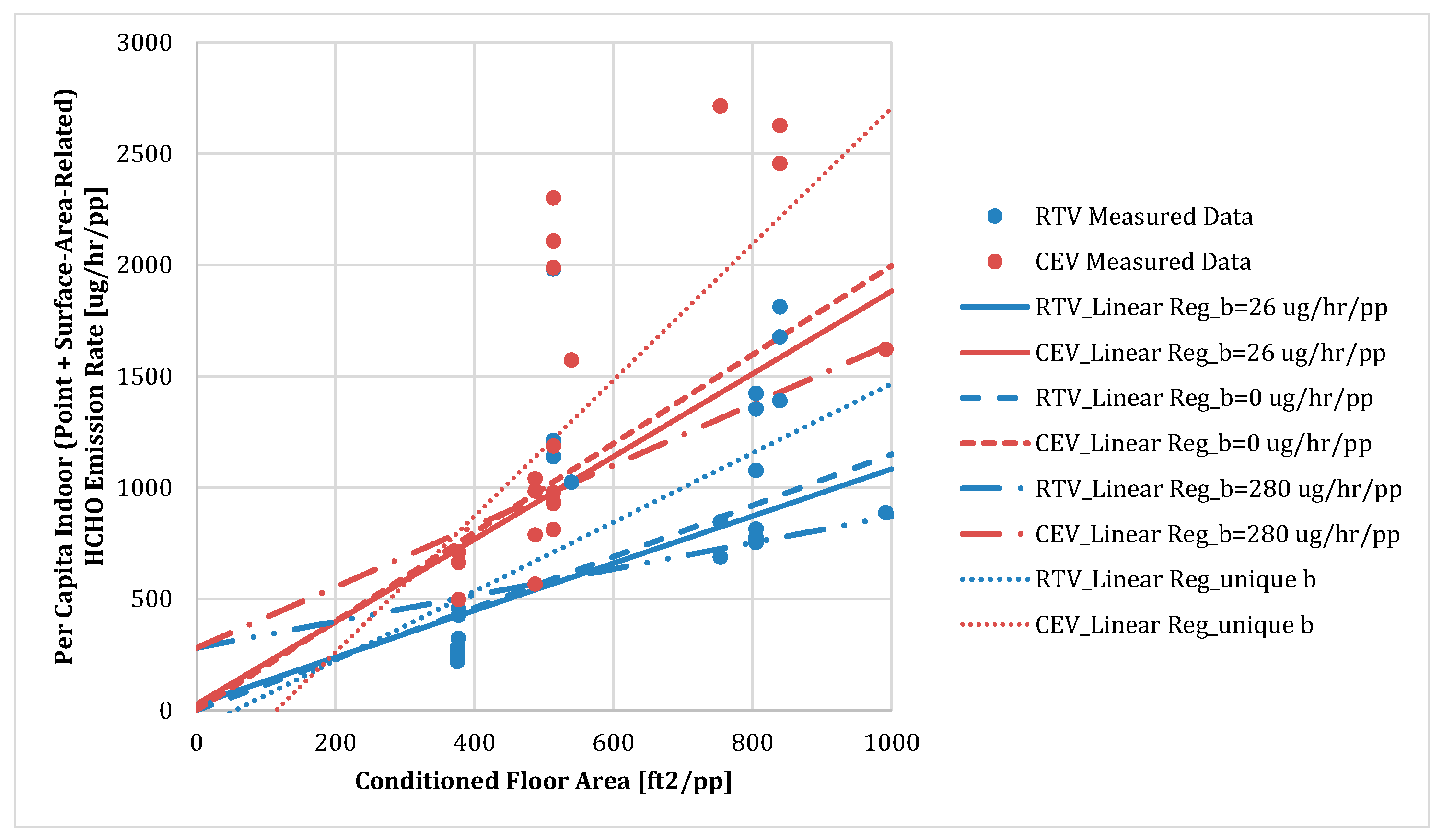Relationship among Concentrations of Indoor Air Contaminants, Their Sources, and Different Mitigation Strategies on Indoor Air Quality
Abstract
:1. Introduction
1.1. Background on Existing Mitigation Approaches
1.2. Theory
- Indoors: Indoor contaminants are introduced periodically as a result of occupant activities (e.g., cooking, cleaning, showering, painting, crafts, etc.) or may be continuously emitted from materials and furnishings in the building (e.g., carpeting, cabinets, drapes, new furniture, etc.). Common sources of building-related pollutant sources consist of paints, adhesives, carpets and fabrics, stored pesticides or cleaning products, synthetic building materials, and indoor combustion sources [16,17,18]. The indoor air pollutants most commonly associated with building materials and building-related activities are formaldehyde and volatile organic compounds (VOCs), while indoor combustion presents a significant source of VOCs and particles [18,19].
- Outdoors: Outdoor contaminants can be introduced incidentally into the building through natural and/or mechanically-induced air infiltration, as well as intentionally as part of the mechanical ventilation system. Typical pollutants in outdoor air include smog (NOx, SOx, and ozone), particulates (dust, allergens, molds), and toxins (accidental or intentional releases) [1]. (While accidental or intentional release of toxins are a real threat to air quality, both indoor and outdoor, such events tend to be infrequent and result in short-duration acute exposures. This research aims to address those chronic contaminants that are generally found in indoor and outdoor environments and, therefore, does not address protection against the infrequent release of large quantities of toxins in the environment or other periodic extreme events (e.g., wildfires).) Radon, is also a known indoor air contaminant that originates outdoors.
- Interstitial or unconditioned spaces: Some contaminants can be introduced into the indoor air from components or spaces that are part of the building (e.g., garages, crawlspaces, attics, and the building envelope itself). In this case, the contaminant of concern may or may not have originated in the space, but it is introduced into the indoor air via such adjacent unconditioned spaces. The type of contaminants found in these locations will vary based on the space; VOCs, moisture, and particles are the most common indoor air contaminants introduced from adjacent interstitial or unconditioned spaces.
2. Materials and Methods
2.1. Data Source
2.2. CO2 Analysis
2.3. Formaldehyde Analysis
3. Results and Discussion
4. Conclusions
Supplementary Materials
Acknowledgments
Funding
Author Contributions
Conflicts of Interest
References
- American Society of Heating, Refrigerating, and Air-Conditioning Engineers (ASHRAE). Guideline 24—Ventilation and Indoor Air Quality in Low-Rise Residential Buildings; ASHRAE: Atlanta, GA, USA, 2015. [Google Scholar]
- Widder, S.H.; Martin, E.; Chasar, D.; McIlvaine, J.; Amos, B.; Fonorow, K. Comparative Performance of Two Ventilation Strategies in the Hot Humid Climate; PNNL-24201; Pacific Northwest National Laboratory: Richland, WA, USA, 2017. Available online: https://www1.eere.energy.gov/buildings/publications/pdfs/building_america/65457.pdf (accessed on 26 June 2017).
- American Society of Heating, Refrigerating, and Air-Conditioning Engineers (ASHRAE) Standards Committee. ASHRAE Standard 62.2—Ventilation and Acceptable Indoor Air Quality in Low-Rise Residential Buildings; ASHRAE: Atlanta, GA, USA, 2016. [Google Scholar]
- U.S. Environmental Protection Agency (EPA). Energy Star Qualified Homes, Version 3 (Rev. 07): National Program Requirements; U.S. Environmental Protection Agency: Cincinnati, OH, USA, 2013. Available online: https://www.energystar.gov/ia/partners/bldrs_lenders_raters/downloads/ES%20NPR%20v84%202015-12-09_clean_508.pdf?1625-c4b3 (accessed on 26 June 2017).
- U.S. Department of Energy (DOE). DOE Zero Energy Ready Home National Program Requirements; Rev. 04; U.S. Department of Energy Building Technologies Office: Washington, DC, USA, 2014. Available online: http://energy.gov/sites/prod/files/2014/04/f15/doe_zero_energy_ready_home_requirements_rev04.pdf (accessed on 26 June 2017).
- Russel, M.E.; Sherman, M.H.; Rudd, A. Review of Residential Ventilation Technologies; LBNL 57730; Lawrence Berkeley National Laboratory: Berkeley, CA, USA, 2005.
- Aubin, D.; Won, D.; Schleibinger, H.; Lajoie, P.; Gauvin, D.; Gingras, V.; Fugler, D. Effectiveness of Ventilation Interventions at Improving Indoor Air Quality and Ventilation Rates in Canadian Single Family Homes with Asthmatic Children. In ASHRAE Indoor Air Quality 2013 in Proceedings of the Environmental Health in Low Energy Buildings, 15–18 October 2013; American Society of Heating, Refrigerating and Air-Conditioning Engineers: Vancouver, BC, Canada, 2013. [Google Scholar]
- Willem, H.; Hult, E.; Hotchi, T.; Russel, M.; Maddalena, R.; Singer, B. Ventilation Control of Volatile Organic Compounds in New U.S. Homes: Results of a Controlled Field Study in Nine Residential Units; LBNL-6022E; Lawrence Berkeley National Laboratory: Berkeley, CA, USA, 2013.
- Hun, D.; Jackson, M.; Shrestha, S. Optimization of Ventilation Energy Demands and Indoor Air Quality in High-Performance Homes. In 2014 ACEEE Summer Study on Energy Efficiency in Buildings: Pacific Grove, CA, USA, August 2014; American Council for an Energy Efficient Economy: Washington, DC, USA, 2014. [Google Scholar]
- Rudd, A.; Bergey, D. Ventilation Systems Effectiveness and Tested Indoor Air Quality Impacts. 2014. Available online: http://www.nrel.gov/docs/fy14osti/61128.pdf (accessed on 26 June 2017).
- Wolkoff, P. Impact of air velocity, temperature, humidity, and air on long-term voc emissions from building products. Atmos. Environ. 1998, 32, 2659–2668. [Google Scholar] [CrossRef]
- Salthammer, T.; Mentese, S.; Marutzky, R. Formaldehyde in the Indoor Environment. Chem. Rev. 2010, 110, 2536–2572. [Google Scholar] [CrossRef] [PubMed]
- Hodgson, A.T.; Moyer, N.; Beal, D. Effect of Residential Ventilation Techniques for Hot and Humid Climates on Indoor Concentration of VOCs; LBNL-57030; Lawrence Berkeley National Laboratory: Berkeley, CA, USA, 2005. Available online: http://www.ba-pirc.org/pubs/pdf/LBNL-57030-Effect.pdf (accessed on 26 June 2017).
- American Society of Heating, Refrigerating, and Air-Conditioning Engineers (ASHRAE). Handbook Fundamentals—Chapter 13: Indoor Environmental Modeling; ASHRAE: Atlanta, GA, USA, 2013. [Google Scholar]
- National Institute of Standards and Technology (NIST). CONTAM. Available online: http://www.bfrl.nist.gov/IAQanalysis/index.htm (accessed on 1 December 2016).
- Spengler, J.D.; Sexton, K. Indoor air pollution: A public health perspective. Science 1983, 221, 9–17. [Google Scholar] [CrossRef] [PubMed]
- Weschler, C.J.; Nazaroff, W.W. Semivolatile organic compounds in indoor environments. Atmos. Environ. 2008, 42, 9018–9040. [Google Scholar] [CrossRef]
- Thatcher, T.L.; Layton, D.W. Deposition, Resuspension, and Penetration of Particles within a Residence. Atmos. Environ. 1995, 9, 1487–1497. [Google Scholar] [CrossRef]
- Dales, R.; Liu, L.; Wheeler, A.J.; Gilbert, N.L. Quality of indoor residential air and health. Can. Med. Assoc. J. 2008, 179, 147–152. [Google Scholar] [CrossRef] [PubMed]
- ASTM International. ASTM E779-10: Standard Test Method for Determining Air Leakage Rate by Fan Pressurization; ASTM International: West Conshohocken, PA, USA, 2010. [Google Scholar]
- American Society of Heating, Refrigerating, and Air-Conditioning Engineers (ASHRAE). ASHRAE Standard 152: Method of Test for Determining the Design and Seasonal Efficiencies of Residential Thermal Distribution Systems; ASHRAE: Atlanta, GA, USA, 2004. [Google Scholar]
- U.S. Green Building Council (USGBC). Reference Guide for Building Design and Construction—Version 4; U.S. Green Building Council: Washington, DC, USA, 2013. [Google Scholar]
- American Society of Heating, Refrigerating, and Air-Conditioning Engineers (ASHRAE). Handbook of HVAC Applications—Chapter 12: Aircraft; ASHRAE: Atlanta, GA, USA, 2015. [Google Scholar]




| Site | Cohort | Area (sqft) | # BRs 1 | Occup. Adult/Child | ACH50 2 (h−1) | Qn, Out 3 (cfm) | RTV Flow (cfm) | Exh. Fan Flow (cfm) | 62.2-2010/2013 Fan Req. 4 (cfm) |
|---|---|---|---|---|---|---|---|---|---|
| 1 | Flip-flop | 2158 | 5 | 2/2 | 5.1 | 3.4 | 40 | 57 | 67/71 |
| 2 | Flip-flop | 1508 | 3 | 2/2 | 4.4 | NA | 34 | 55 | 45/52 |
| 3 | CEV | 1542 | 3 | 1/2 | 3.0 | 2.2 | N/A | 54 | 45/60 |
| 4 | Flip-flop | 1984 | 4 | 2/0 | 3.4 | 3.0 | 26 | 55 | 57/73 |
| 5 | CEV | 1950 | 4 | 2/2 | 3.0 | 1.6 | NA | 59 | 57/75 |
| 6 | Flip-flop | 1679 | 3 | 2/0 | 3.5 | 1.8 | 42 | 55 | 47/60 |
| 7 | RTV | 1878 | 4 | 2/3 | 3.4 | 1.0 | 35 | NA | 56/71 |
| 8 | Flip-flop | 1508 | 3 | 1/1 | 2.9 | 1.5 | 39 | 78 | 45/60 |
| 9 | Flip-flop | 1542 | 3 | 3/0 | 4.8 | 2.0 | 24 | 64 | 45/50 |
| 10 | RTV | 2416 | 4 | 2/1 | 2.6 | 4.6 | 37 | NA | 62/87 |
| Flip-flop average | 1730 | 3.5 | 2.0/0.8 | 4.0 | 2.1 | 34 | 61 | 51/61 | |
| Control average | 1947 | 3.8 | 1.8/2.0 | 3.0 | 2.4 | 36 | 57 | 55/73 | |
| Overall average | 1817 | 3.6 | 1.9/1.3 | 3.6 | 2.2 | 35 | 60 | 53/66 |
| Parameter | Unit | Runtime Ventilation Strategy | Continuous Exhaust Ventilation Strategy | Ratio (CEV/RTV) |
|---|---|---|---|---|
| Air Exchange Rate (Mechanical and Natural) | h−1 | 0.14 ± 0.01 | 0.26 ± 0.02 | 1.81 ± 0.02 |
| CO2 Concentration | ppm | 522 ± 73 | 346 ± 48 | 0.66 ± 0.17 |
| Formaldehyde Concentration | ppb | 26 ± 5 | 24 ± 4 | 0.93 ± 0.24 |
| Formaldehyde Emission Rate | μg/h | 1.2 ± 0.3 | 2.0 ± 0.4 | 1.75 ± 0.53 |
| Y-Intercept | RTV | CEV | Emission Rate Ratio (CEV/RTV) |
|---|---|---|---|
| 26 μg/h | (1.2 ± 0.3) × CFA + (26 ± 254) | (2.1 ± 0.4) × CFA + (26 ± 254) | 1.75 ± 0.53 |
| 0 μg/h | (1.3 ± 0.3) × CFA + 0 | (2.2 ± 0.4) × CFA + 0 | 1.73 ± 0.50 |
| 280 μg/h | (0.7± 0.3) × CFA + 280 | (1.5 ± 0.5) × CFA + 280 | 2.22 ± 0.56 |
| Unique | (1.6 ± 0.4) × CFA + (−87 ± 264) | (1.6 ± 0.4) × CFA + (−87 ±2 64) | 1.97 ± 0.86 |
| Season | RTV | CEV |
|---|---|---|
| Summer | 1.2 ± 0.4 | 2.1 ± 0.6 |
| Winter | 1.1 ± 0.5 | 1.8 ± 0.9 |
| Overall | 1.2 ± 0.3 | 2.0 ± 0.4 |
| Formaldehyde | Average from [8] | Gainesville Data | ||
| Low/High | Medium/High | Overall | RTV/CEV | |
| Concentration Ratio | 2.2 | 1.5 | 1.9 | 1.1 |
| Emission Rate Ratio | 0.7 | 0.8 | 0.7 | 0.6 |
| High/Low | High/Medium | Overall | CEV/RTV | |
| Ventilation Rate Ratio | 3.2 | 1.9 | 2.6 | 1.8 |
© 2017 by the authors. Licensee MDPI, Basel, Switzerland. This article is an open access article distributed under the terms and conditions of the Creative Commons Attribution (CC BY) license (http://creativecommons.org/licenses/by/4.0/).
Share and Cite
Widder, S.H.; Haselbach, L. Relationship among Concentrations of Indoor Air Contaminants, Their Sources, and Different Mitigation Strategies on Indoor Air Quality. Sustainability 2017, 9, 1149. https://doi.org/10.3390/su9071149
Widder SH, Haselbach L. Relationship among Concentrations of Indoor Air Contaminants, Their Sources, and Different Mitigation Strategies on Indoor Air Quality. Sustainability. 2017; 9(7):1149. https://doi.org/10.3390/su9071149
Chicago/Turabian StyleWidder, Sarah H., and Liv Haselbach. 2017. "Relationship among Concentrations of Indoor Air Contaminants, Their Sources, and Different Mitigation Strategies on Indoor Air Quality" Sustainability 9, no. 7: 1149. https://doi.org/10.3390/su9071149





